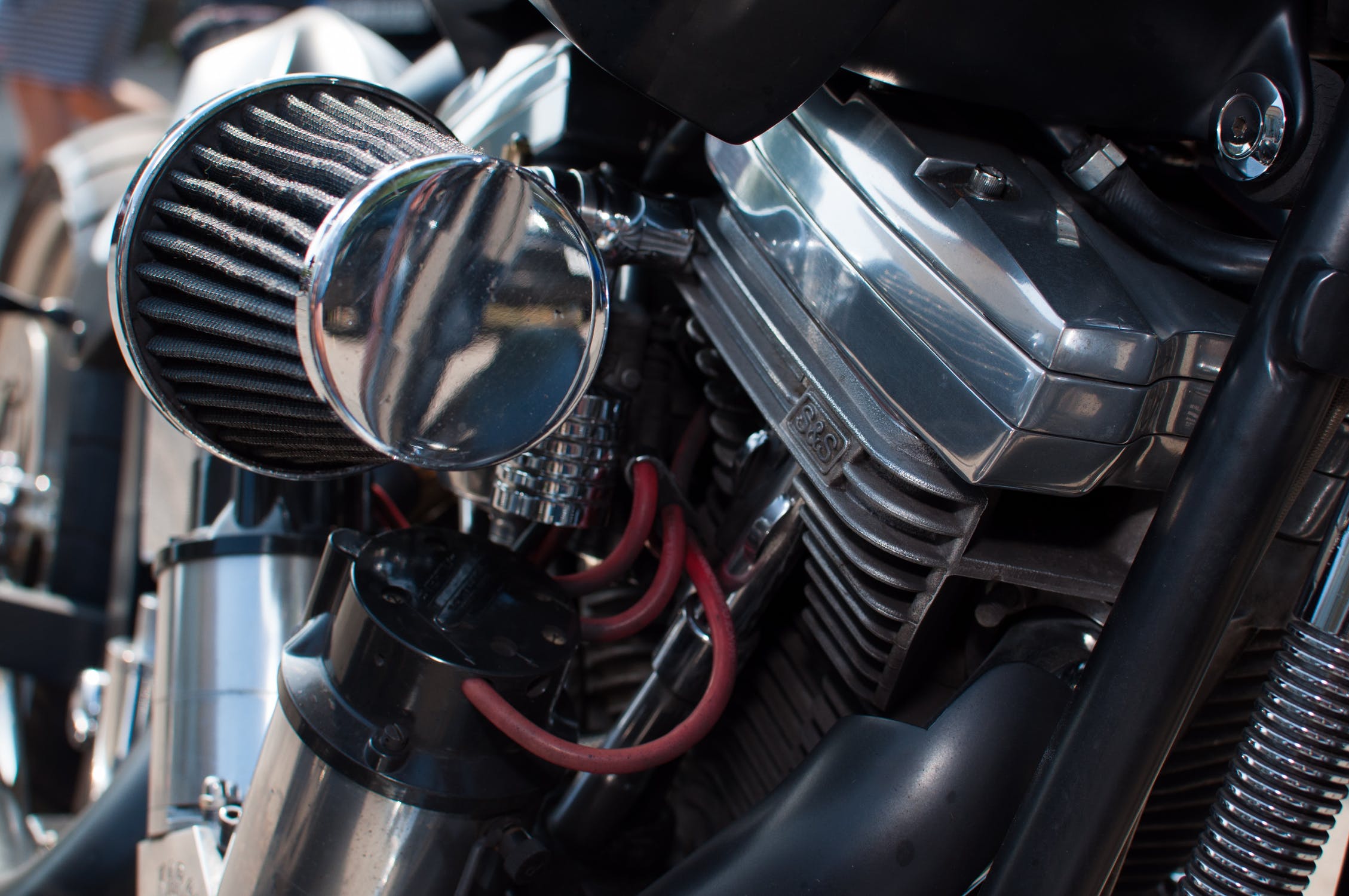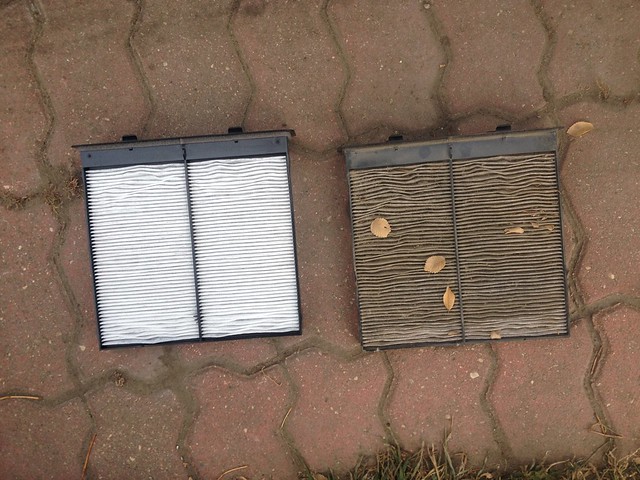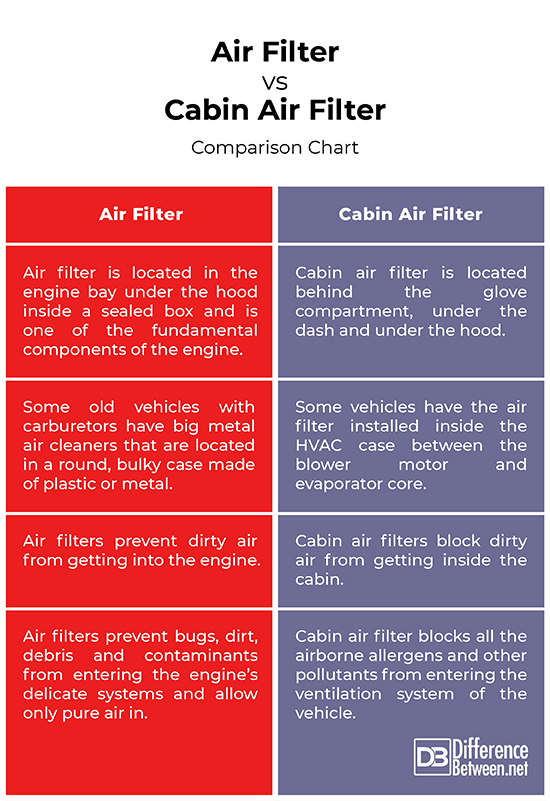Difference Between Air Filter and Cabin Filter
Just like human body requires oxygen to function and to survive, a vehicle’s engine needs oxygen to control how much gasoline it can burn to power the engine. And the oxygen comes from the air all around us. But the air needs to be cleaned before it enters the engine in order to capture dirt, pollen and other pollutants from reaching its sensitive internals. An average car has many different types of filters to prevent air, fuel, oil and water from contaminants such as carburetor air filter, cabin air filter, crank base breather filter, ABS wheel/brake filter, power steering filters, engine oil filters, fuel tank filter, transmission filters, and more.
The basic air filters in automobiles can be classified as the engine air filter and cabin air filter. Air filters clean the air and prevent the impurities within the air, which is used by the engine during combustion. It is located in the engine bay inside a sealed box. The air filter makes sure the air is free from the contaminants before it enters into the engine. The cabin air filter is yet another feature used in many vehicles today. It is a second air filter installed in the duct system to filter out pollen and dust particles that enter a vehicle through its heating, air conditioning and defrost systems. Both are fairly similar in what they do but their purposes are slightly different.
What is Air Filter?
Air filters, also goes by internal combustion air filters, as the name suggest, filter the air and prevent the impurities within the air from entering the engine during combustion. The air filters directly or indirectly protects the components of the engine from daily wear. They are the vehicle’s first line of defense against the pollutants and contaminants from damaging your engine. The air filters prevent bugs, dirt, debris and contaminants from entering the engine’s delicate systems, thereby reducing emissions and improving the performance of the vehicle. The idea is to block the larger particles from getting inside the engine intake and allow only pure air in, in order to keep the vehicle operating in top condition. Dirty air can reduce the efficiency of the engine and may cause damage to the engine, so it is always advisable to change the air filter every now and then to keep your vehicle in its best condition.
What is Cabin Air Filter?
Cabin air filter is a second air filter installed in the duct system to filter out pollen and dust particles which would otherwise enter the interior of the vehicle. Cabin air filters are designed to block dirt, pollen, bugs, and other contaminants from entering a vehicle through its heating, air conditioning and defrost systems. Cabin air filters are typically located behind the glove compartment, under the dash and under the hood, while some vehicles have the air filter installed inside the HVAC case between the blower motor and evaporator core. As a vehicle travels down the road or sitting in traffic, the air outside the vehicle, which contains all kinds of pollens and impurities, is sucked inside through the fresh air intake system even when the blower motor is off. This adversely affects the operation of the HVAC system. The cabin air filter blocks all the airborne allergens and other pollutants from entering the ventilation system of the vehicle.
Difference between Air Filter and Cabin Air Filters
Location
The air filter is located in the engine bay under the hood inside a sealed box and is one of the fundamental components of the engine. The life expectancy of the engine depends on the quality of the air that enters the engine and if the air is dirty, it adversely affects the performance of the vehicle. Cabin air filters, on the other hand, are typically located behind the glove compartment, under the dash and under the hood, while some vehicles have the air filter installed inside the HVAC case between the blower motor and evaporator core.
Purpose
The main purpose of air filters is to clean the air and prevent the impurities within the air, which is used by the engine during combustion. Air filters block the larger particles from getting inside the engine intake and allow only pure air in, in order to keep the vehicle operating in top condition. The purpose of cabin air filters is to block dirt, pollen, bugs, and other contaminants from entering a vehicle through its heating, air conditioning and defrost systems. So, air filters prevent dirty air from getting into the engine, while cabin air filters block dirty air from getting inside the cabin.
Air Filter vs. Cabin Air Filter: Comparison Chart
Summary of Air Filter vs. Cabin Air Filter
In a nutshell, both air filters and cabin air filters are basically the same; they purify dirty air and allow only pure air in. However, air filters prevent dirty air from getting into the engine whereas cabin air filters block dirty air from getting inside the cabin. The air filters protect the components of the engine from wear, while cabin air filters prevent the airborne allergens and pollutants from entering inside the cabin thereby improving the quality of the cabin air. Cabin air filter is like a second air filter installed in the duct system to filter out pollen and dust particles that enter a vehicle through its heating, air conditioning and defrost systems.
- Difference Between Caucus and Primary - June 18, 2024
- Difference Between PPO and POS - May 30, 2024
- Difference Between RFID and NFC - May 28, 2024
Search DifferenceBetween.net :
Leave a Response
References :
[0]Image credit: https://www.pexels.com/photo/air-filter-chrome-chrome-gloss-cult-371884/
[1]Image credit: https://www.flickr.com/photos/ryangsell/10789771066
[2]Schnubel, Mark. Automotive Heating & Air Conditioning (4th ed.). Boston, Massachusetts: Cengage Learning, 2008. Print
[3]Erjavec, Jack. Automotive Technology: A Systems Approach. Boston, Massachusetts: Cengage Learning, 2009. Print
[4]Camlibel, Nurhan Onar. Polyester: Production, Characterization and Innovative Applications. London: IntechOpen, 2018. Print



